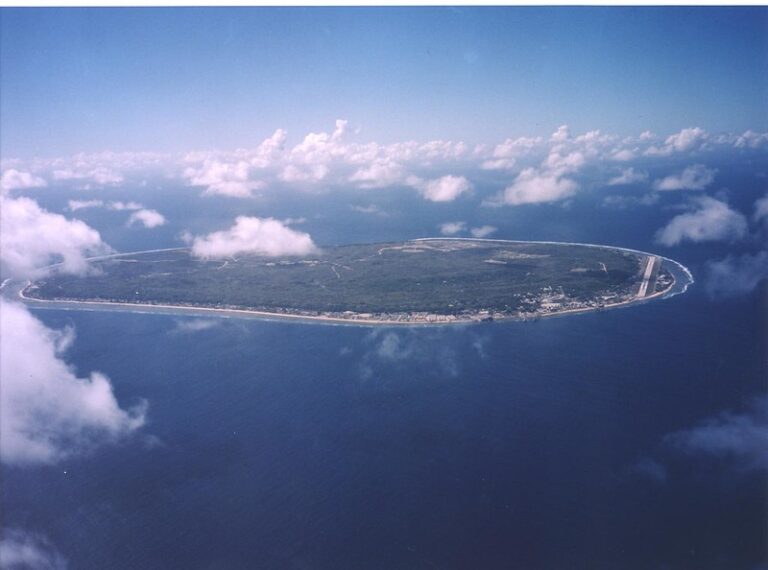Small Island Developing States need innovative forms of finance to bridge the devastating ‘adaptation gap’

COP29 has been criticised for failing to deliver substantial and accessible adaptation finance to support developing countries as they deal with climate change impacts. This poses particular challenges for highly-vulnerable Small Island Developing States, who might turn to environmentally-damaging alternatives such as deep-sea mining to plug the gap, write Lea Reitmeier and Denyse S. Dookie.
The world is nearing a +1.5°C rise in surface temperature much faster than predicted, with growing evidence of irreversible impacts. For Small Island Developing States (SIDS), climate change is no longer a distant threat. Extreme weather events linked to climate change such as flooding and tropical cyclones are already severely affecting SIDS’ economies, challenging recovery and resilience-building; for example, Dominica lost over 200% of its GDP following Hurricane Maria in 2017. In addition, slow-onset phenomena such as sea level rise, coastal erosion and saltwater intrusion are intensifying the threat. Despite being limited contributors to global emissions, climate change continues to disproportionately affect these nations, disrupting lives, livelihoods and economies.
Why is there such urgency to scale up adaptation finance for SIDS?
SIDS have often been described as a ‘special case’ for sustainable development. As well as the impact of external shocks such as natural hazards and global economic crises, they are highly vulnerable to a complex set of factors including geographical isolation and high transport costs, limited natural resources, lack of updated infrastructure, skills gaps, labour shortages, and diseconomies of scale, which limit economic diversification. SIDS often rely on external markets and trade, as well as sectors sensitive to climate disruptions, such as tourism, agriculture and fishing.
Recurring and frequent climate and disaster impacts in SIDS require adequate financing to maintain economic stability and build resilience. However, the use of traditional measures of development to determine access to climate finance trivialises the unique structural vulnerabilities of SIDS. Metrics such as Gross National Income (GNI) per capita, in particular, may show comparatively high values for SIDS nations due to their relatively small populations, without adjustment for island-specific climate adaptation costs. This is a factor in half of all SIDS being classified by the World Bank as high-income economies, which poses a significant barrier to affordable financing options.
Adaptation finance needs for SIDS are disproportionately high compared with other nations. On average, SIDS require 3.4% of GDP annually, far exceeding the 1.4% required to adapt to climate change by other developing countries. Modelled costs for adaptation in SIDS are estimated at US$5.1 billion per year. Yet, actual public adaptation finance flows to SIDS are only about US$1.4 billion per year – covering less than one-third of the needs.
Despite the urgency, the annual funding volume of new adaptation projects under the financial mechanisms of the Paris Agreement – the Adaptation Fund (AF), Green Climate Fund (GCF) and Global Environment Facility (GEF) – have remained the same for over five years at just under US$500 million per year. About 37% of adaptation finance to SIDS is supplied through loans, which adds to the debt burden.
It is crucial that adaptation finance consists of grants, concessional loans and other innovative finance instruments, especially given the debt crisis in many SIDS. It is estimated that nearly half of SIDS are nearing or are already in debt distress, which encourages debt servicing rather than investment in social services and resilience building. Credit rating agencies often view growing debt levels negatively, prioritising short-term liquidity over the long-term investments needed for climate resilience. Further, their methodologies typically focus on the potential economic damage from the exposure to climate-related risks and rarely consider the benefits of investing in climate resilience. This creates a vicious cycle for SIDS since asset managers and pension funds use these ratings and assessments to inform investment decisions. With poor credit ratings, SIDS and other vulnerable nations therefore become less attractive to investors, which limits their access to private finance or worsens the finance terms. Initial discussions to overhaul the ratings have started.
COP29 and the missed opportunity
At COP29, high-income countries had the opportunity to support the growing climate-related financial needs of vulnerable nations. But despite the urgent need, the summit failed to deliver the necessary increase in financial flows. At the same time, the UN’s Adaptation Gap Report 2024 highlights that adaptation financing must move beyond incremental measures and focus on strategic, anticipatory and transformational measures. These efforts remain underfinanced, and funding the easiest-to-finance projects will not deliver the scale or complexity of adaptation required.
The challenges faced by SIDS are set to intensify. Currently, there are 12 SIDS that might exceed the income threshold by 2030 that qualifies them to receive official development assistance (ODA). Countries that exceed the threshold of US$13,845 GNI per capita for three consecutive years will be excluded from the ‘upper middle-income country’ category. For example, in 2026 Nauru will graduate from the Development Assistance Committee’s list of ODA recipients, effectively severing its access to significant concessional funding sources.
The failure of COP29 to prompt wealthy economies to both increase their support and reduce the bureaucratic hurdles to access finance, compounded by the pressing need to secure the necessary financial resources to facilitate adaptation measures, may prompt some nations to explore alternative avenues for financial support that incur long-term risk – such as deep-sea mining.
The lure of deep-sea mining
Deep-sea mining involves extracting minerals such as polymetallic nodules from the ocean floor, often beneath the high seas. Countries that have contracts from the International Seabed Authority (ISA) can grant companies access to the resources, even if the nodules are not in close proximity to their land. In return, companies engaged in exploitation of minerals would be expected to pay a tax to the sponsoring state, plus taxes to the ISA. One estimate places the former at 25% corporate income tax and the latter after year four at a US$1 million exploitation licence plus an annual fee of US$100,000 and a 6% royalty on the total value of metals recovered. For cash-strapped nations in particular, the additional direct income and prospective income through the ISA benefit-sharing mechanism could prove very attractive.
Nauru, for example, is particularly exposed to sea-level rise, is geographically isolated and has limited economic opportunities. The estimated cost of climate change adaptation and mitigation projects in its Nationally Determined Contribution (NDC) is around US$76 million. Taxes and royalties from deep-sea mining could provide a significant and relatively stable form of financial flows for Nauru and small nations like it. In contrast to the often-cumbersome bureaucratic processes to access international climate funds, additional tax income is unconstrained in its use and does not add to debt burden. Government can use this revenue to invest in strategic, anticipatory, and transformational adaptation measures.
Unfortunately, the environmental risks associated with deep-sea mining are considerable. Mining activities can disrupt marine ecosystems, affecting fish stocks, natural coastal protection systems and even tourism – further exacerbating the challenges faced by SIDS. Sufficient financial support via the international mechanisms, as discussed during COP29, would have provided a more sustainable pathway for SIDS while protecting ecosystems and the services they provide.
It is noteworthy that many of the developed countries advocating for a moratorium on deep-sea mining are the same nations that failed to provide support to SIDS during COP29. This duality highlights a significant deficit in climate justice and undermines the principle of ‘common but differentiated responsibility and respective capabilities’.
Closing the gap
Providing adequate climate finance is not just a matter of limiting the devastating impacts of climate change: it is also essential to prevent further environmental harm that might arise from desperate measures taken by vulnerable nations given the lack of alternatives, and to safeguard livelihoods, ensuring long-term resilience for vulnerable populations. Closing the gap requires urgent action, including scaling up grant-based finance, reducing reliance on non-concessional loans, and ensuring equitable and inclusive financing arrangements aligned with global climate justice principles. This may also necessitate a move away from traditional measures of development and need, and towards the design and implementation of a Multidimensional Vulnerability Index.
COP29 was a missed opportunity. Now, the wealthy countries most responsible for historic emissions must support climate-vulnerable communities, moving beyond rhetoric and fulfilling their financial commitments.
The authors are grateful to Timo Leiter and Georgina Kyriacou for reviewing this commentary.

